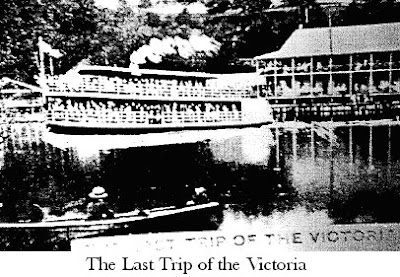 For the last few weeks I've been following the potential fate of Sparta's 'Moore House' with some trepidation. The 183 year-old home (which predates Eldon House's construction by a decade) is presently facing demolition due to the new property owner's decision to build on the site. The house was built completely from local materials and is considered one of the earliest remaining brick homes in Southwestern Ontario. The builder of the home, John Moore, was a Quaker whose father, a United Empire Loyalist, settled in the area after the American Revolutionary War.
For the last few weeks I've been following the potential fate of Sparta's 'Moore House' with some trepidation. The 183 year-old home (which predates Eldon House's construction by a decade) is presently facing demolition due to the new property owner's decision to build on the site. The house was built completely from local materials and is considered one of the earliest remaining brick homes in Southwestern Ontario. The builder of the home, John Moore, was a Quaker whose father, a United Empire Loyalist, settled in the area after the American Revolutionary War.It should come as no surprise to those who know me that I want this house saved. After the Central Elgin council voted 4-3 against protecting the home under Ontario's heritage law - despite Central Elgin's heritage advisory committee's plea for protection - I had resigned myself to the fact that Moore House would soon disappear, like so many of its predecessors, without so much as a commemorative plaque. It seems, however; that I underestimated the public's interest in our region's heritage.
In a letter addressed to Central Elgin's council from Colin Read (former president of the Ontario Historical Society), Read states: "keeping the best structures of the past for the socialization and edification of present and future generations pays large dividends in the form of tourism and, even more importantly, in an enhanced sense of community. This vital lesson is too easily missed by many in these largely ahistorical times." A similar sentiment was expressed in a letter to the editor by Joseph O'Neil, Chair of London's Advisory Committee on Heritage, on September 25th 2007: "The Moore House in Sparta has much deeper significance than just it’s age...Why such history is never taught in our local schools is beyond me, but it is an obvious reason why we have to fight so hard to preserve one of the few remaining links to a magnificent past." These letters were followed by dozens of others from both local and provincial heritage organizations and - in what seems too often a very rare turn of events - actually seem to have had an impact.
On Saturday Sept 22nd 2007, Ontario Culture Minister Caroline Di Cocco issued a stop order on the demolition of Moore House. Though the future of the house remains uncertain (a stop order only prevents demolition for 60 days while the property's historical significance is further reviewed), it is sites such as this which fostered my initial interest in history. Even the temporary protection of Moore House gives me hope for the future of other heritage properties and helps to remind me why making history relevant to non-academic audiences is a noble pursuit.
Image from:
Simunac, Daniela. "Council opts against protection for 183-year-old Moore house." lfpress.com. September 19, 2007. http://lfpress.ca/cgi-bin/publish.cgi?x=articles&p=197395&s=politics (accessed September 28, 2007).

